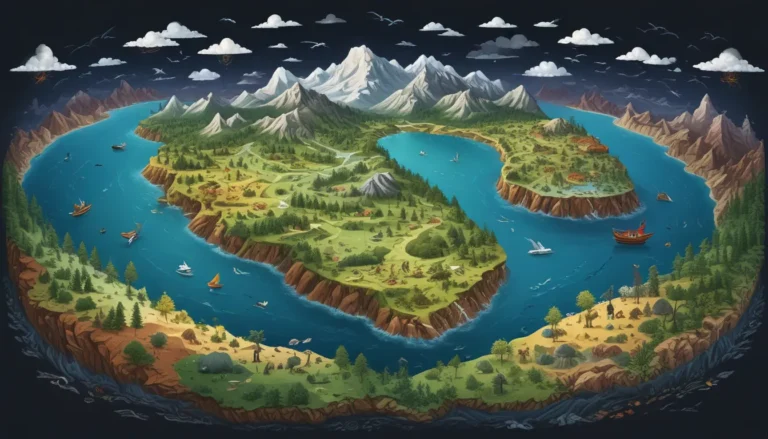A Note About Images: The images used in our articles are for illustration purposes only and may not exactly match the content. They are meant to engage readers, but the text should be relied upon for accurate information.
Welcome to the intriguing world of geomorphology, where the Earth’s ever-changing landscapes come to life through scientific exploration. From the majestic mountains to the winding rivers and vast deserts, the study of geomorphology unravels the mysteries behind the processes that shape our planet’s surface. In this article, we will uncover 20 extraordinary facts about geomorphology that will leave you amazed at the wonders of our natural world. Whether you are a geography enthusiast or simply curious about the intricacies of our planet, these facts will provide you with a deeper appreciation for the beauty and complexity of geomorphology. So, let’s embark on this journey through the remarkable world of Earth’s ever-changing landforms.
Delving Into Geomorphology: An Insightful Exploration
Geomorphology is the scientific study of the Earth’s landforms and the processes that shape them. It delves into the forces of nature, such as erosion, weathering, and plate tectonics, that give rise to the diverse features we see on our planet today. By unraveling the secrets hidden beneath the Earth’s surface, geomorphologists act as detectives investigating how landscapes were formed and changed over time. This knowledge is not only essential for understanding the geological history of our planet but also plays a crucial role in addressing present-day challenges such as climate change and natural hazards.
The Grand Canyon: A Testimony to Geomorphological Forces
The remarkable formation of the Grand Canyon stands as a testament to the power of geomorphological processes. Over millions of years, the Colorado River carved its way through layers of sedimentary rock, creating one of the most breathtaking natural wonders on Earth. This awe-inspiring landscape showcases the intricate dance between water, rock, and time, highlighting the immense impact of geomorphology on shaping our world.
Geomorphology and Climate Change: A Crucial Connection
Geomorphology plays a pivotal role in understanding climate change by studying landforms and their changes over time. By analyzing past climate patterns, geomorphologists can provide valuable insights into predicting future climate scenarios and formulating effective strategies for climate change mitigation and adaptation. The intricate relationship between geomorphology and climate change underscores the importance of this field in tackling one of the most pressing global challenges of our time.
Mount Everest: A Majestic Product of Geomorphic Processes
The towering peak of Mount Everest, the highest point on Earth, is a result of geomorphic processes at work. Standing at 8,848 meters (29,029 feet), this majestic mountain is a testament to the collision between the Indian and Eurasian tectonic plates. Geomorphological processes, including uplift and erosion, have shaped Mount Everest over millions of years, showcasing the dynamic interplay between geological forces and the formation of iconic landforms.
Unveiling Modern Tools of Geomorphology: A Technological Marvel
Geomorphologists utilize advanced technologies such as Lidar (Light Detection and Ranging), satellite imagery, and geographic information systems (GIS) to study and analyze landforms with precision and accuracy. These cutting-edge tools provide valuable data about the characteristics of mountains, rivers, and caves, aiding in environmental protection, urban planning, and unlocking the Earth’s hidden secrets buried beneath its surface.
Exploring the Fascinating Formation of River Deltas
The formation of river deltas, such as the Nile Delta and Mississippi Delta, presents a captivating geomorphic phenomenon. These intricate landforms are created as rivers deposit sediment at their mouths, leading to a complex interplay between rivers, ocean currents, and sediment transport. Geomorphologists study river deltas to unravel the dynamic processes shaping these landscapes, shedding light on the interaction between water bodies and terrestrial environments.
Harnessing Geomorphology for Groundwater Management
Geomorphologists play a vital role in understanding aquifer systems and managing groundwater resources sustainably. By studying the relationship between landforms and underground water sources, they assist in locating and protecting crucial aquifers for human use and ecological balance. Their research contributes to the conservation and sustainable management of groundwater, ensuring the long-term availability of this precious natural resource.
Ecological Insights Through Geomorphology: A Conservation Imperative
The study of landforms and their impact on ecosystems allows geomorphologists to assess the ecological significance of different landscapes. This knowledge is instrumental in developing conservation strategies and protecting biodiversity-rich areas. By unraveling the intricate connections between landforms and ecosystems, geomorphologists play a vital role in preserving the natural heritage and ecological balance of our planet.
Embracing Diversity in Geomorphological Sub-disciplines
Geomorphology encompasses a diverse range of sub-disciplines, including fluvial, coastal, and glacial geomorphology. Fluvial geomorphology focuses on rivers and their dynamics, coastal geomorphology explores coastal landforms and processes, and glacial geomorphology investigates the formation and effects of glaciers on the landscape. Each sub-discipline offers unique insights into the dynamic processes shaping Earth’s diverse landforms.
Deciphering Geological History Through Geomorphology
Through the analysis of landforms, sediment layers, and fossils, geomorphologists can unravel the geological history of the Earth. From periods of glaciation to volcanic activity and shifts in climate patterns, geomorphology offers a window into the past, providing valuable insights into the evolution of our planet over millions of years. This deep dive into geological history showcases the power of geomorphology in deciphering the mysteries of our planet’s past.
Navigating Human Impacts on Geomorphological Processes
Geomorphologists study the effects of human activities on landforms and ecosystems, including deforestation, urbanization, and mining. By understanding the impact of these interventions, geomorphologists can develop sustainable practices to minimize negative impacts and safeguard the integrity of natural landscapes. Their research highlights the intricate balance between human activities and geomorphological processes, paving the way for environmentally conscious practices and sustainable development.
Geomorphology as a Pillar of Engineering and Infrastructure
Understanding the geological and geomorphological characteristics of an area is essential for engineering projects and infrastructure development. By leveraging insights from geomorphology, engineers can design structures that are resilient to natural hazards and ensure the long-term stability of infrastructure projects. The integration of geomorphological knowledge into engineering practices highlights the critical role of this field in shaping resilient and sustainable built environments.
Beyond Earth: Geomorphology Across Celestial Bodies
Geomorphologists extend their explorations beyond Earth to investigate landforms and processes on other celestial bodies such as Mars and the Moon. By analyzing the geological features of these extraterrestrial landscapes, geomorphologists provide insights into the geologic history of these planets, unlocking the mysteries of our solar system’s evolution. This cosmic journey expands the boundaries of geomorphology, offering a glimpse into the unique landscapes of distant worlds.
Unraveling the Dynamics of Sediment Transport Through Geomorphology
Studying erosion, deposition, and sediment transport in rivers and oceans, geomorphologists contribute to enhancing our understanding of water resource management and protecting aquatic habitats. By investigating the intricate processes governing sediment transport, geomorphologists play a crucial role in preserving the health of aquatic ecosystems and ensuring sustainable water resource management. Their research sheds light on the complex interplay between water bodies and the surrounding landscapes, highlighting the importance of geomorphology in safeguarding our natural resources.
Delving Into the Mysteries of Caves and Karst Landscapes
Geomorphologists explore the formation and evolution of caves and karst landscapes, unraveling the intricate processes that shape these unique underground environments. From the dissolution of limestone to the formation of stalactites and stalagmites, these underground landscapes hold a wealth of secrets waiting to be unearthed. Geomorphologists delve into the depths of these cavernous realms, shedding light on the fascinating processes that sculpt the hidden wonders beneath the Earth’s surface.
Preserving Archaeological Sites Through Geomorphology
Geomorphologists contribute to archaeology and cultural heritage preservation by examining the landforms and geological materials surrounding archaeological sites. By unraveling the geological history of these sites, geomorphologists help archaeologists uncover hidden artifacts, understand past human-environment interactions, and preserve cultural heritage for future generations. Their expertise in deciphering the geological context of archaeological sites highlights the crucial role of geomorphology in preserving our cultural heritage and understanding the ancient civilizations that once thrived on these lands.
Comprehending Land Degradation and Desertification Through Geomorphology
Geomorphologists study the processes leading to land degradation and desertification, including soil erosion and wind action. By investigating these challenges, geomorphologists develop strategies to combat the detrimental effects of these processes and promote sustainable land management practices. Their research underscores the importance of geomorphology in addressing land degradation and desertification, safeguarding the health of ecosystems and ensuring the sustainable utilization of land resources.
Navigating Land-Use Planning and Natural Resource Management with Geomorphology
Analysing landforms, geomorphologists assist in determining suitable land-use practices, protecting sensitive areas, and ensuring the sustainable utilization of natural resources. By integrating geomorphological insights into land-use planning, policymakers and land managers can make informed decisions that balance human needs with environmental sustainability. Geomorphology serves as a compass guiding the responsible management of natural resources, preserving the integrity of landscapes and fostering harmonious coexistence between human activities and the natural environment.
Dynamic Evolution of Geomorphology: Embracing Advancements in Technology
Innovations in technology, such as remote sensing and computer modeling, have revolutionized the field of geomorphology, allowing scientists to explore landforms and processes with unparalleled detail and accuracy. These cutting-edge tools provide geomorphologists with new avenues for research and discovery, pushing the boundaries of our understanding of Earth’s ever-changing landscapes. The dynamic evolution of geomorphology showcases the interdisciplinary nature of this field and its endless potential for uncovering the mysteries of our planet.
Conclusion: Unveiling the Mysteries of Earth’s Ever-Changing Landscapes
Geomorphology stands as a beacon of discovery, unravelling the intricate processes that shape our planet’s diverse landforms. From the formation of mountains to the evolution of river valleys and coastlines, geomorphologists illuminate the dynamic forces at play in shaping our environment. The 20 extraordinary facts about geomorphology presented in this article offer a glimpse into the vast realm of knowledge and discoveries within this field.
By delving into the realm of geomorphology, we gain a profound appreciation for the complex interplay between geological forces, climate dynamics, and human activities that shape our world. Geomorphologists serve as stewards of the Earth, unraveling its geological history and predicting future changes, guiding us towards sustainable practices and informed decision-making. Through their dedication and expertise, we unlock the secrets of Earth’s ever-changing landscapes, paving the way for a harmonious relationship between humanity and the natural world.
Frequently Asked Questions
-
What is geomorphology?
Geomorphology is the scientific study of the Earth’s landforms, the processes that shape them, and the forces that drive these processes. -
How is geomorphology important?
Geomorphology helps us understand how landscapes are formed and how they change over time. It has implications for land management, urban planning, and environmental conservation. -
What are some examples of landforms studied in geomorphology?
Examples of landforms studied in geomorphology include mountains, valleys, plateaus, plains, canyons, and coastlines. -
How do geological forces shape landforms?
Geological forces such as tectonic activity, erosion, weathering, and deposition play a significant role in shaping landforms over millions of years. -
What are some methods used in geomorphology?
Geomorphologists use various methods, including field observations, remote sensing, GIS (Geographic Information System), and laboratory analysis of rock and soil samples. -
How does human activity affect geomorphological processes?
Human activities such as deforestation, mining, and urbanization can accelerate erosion, alter natural drainage patterns, and impact geomorphological processes. -
Can geomorphology help predict natural hazards?
Yes, through studying past events and understanding the underlying processes, geomorphologists can contribute to predicting natural hazards such as landslides, floods, and earthquakes. -
How does climate change influence geomorphology?
Climate change can affect geomorphological processes by altering rainfall patterns, increasing glacier melt, and influencing sea-level rise, leading to changes in river systems, coastal erosion, and other landscape modifications. -
What are the career opportunities in geomorphology?
Career opportunities in geomorphology include working as a researcher in academia, government agencies, or consulting firms, as well as environmental planning, natural resource management, and geotechnical engineering. -
How can I learn more about geomorphology?
You can learn more about geomorphology by studying geology, geography, or earth science in educational institutions, attending conferences, conducting fieldwork, and exploring scientific literature in the field.
Our Commitment to Quality and Authenticity
Our commitment to delivering trustworthy and engaging content is at the heart of what we do. Each fact on our site is contributed by real users like you, bringing a wealth of diverse insights and information. To ensure the highest standards of accuracy and reliability, our dedicated editors meticulously review each submission. This process guarantees that the facts we share are not only fascinating but also credible. Trust in our commitment to quality and authenticity as you explore and learn with us.






